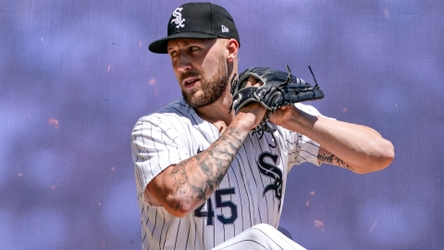One of the things at the top of the list for the Mets this offseason will be rebuilding a rotation that could be losing three core members from the 2024 group.
They’ve extended one-year, qualifying offers to free agents Sean Manaea and Luis Severino, and Jose Quintana is also a free agent.
Manaea will almost certainly reject the QO and hit the free agent market.
Regarding Severino, the possibility exists that he could accept the QO, which would bring him back to the Mets for 2025.
As things currently stand, the Mets’ rotation ahead of 2025 consists of Kodai Senga (who should be healthy after a 2024 that was lost to multiple injuries) and David Peterson, with depth options that include Paul Blackburn (assuming he’s offered arbitration), Jose Butto, and Tylor Megill.
There are a handful of ace-level starting pitchers on the free agent market — Corbin Burnes, Max Fried, and Blake Snell. There’s also Walker Buehler, who is coming off Tommy John surgery and a down 2024, but has ace potential if he can regain his form.
Also available is 23-year-old Japanese ace Roki Sasaki, whose age and years of service in Japan will limit him to a minor league deal, with interested teams able to only offer their international bonus pool money to him. Pretty much every team will be involved, but it will be an upset if he doesn’t wind up with the Dodgers.
Then there’s the trade market.
Starting pitchers like the Marlins’ Jesus Luzardo and the Cardinals’ Erick Fedde could be moved, but the biggest and best name on the market will be White Sox ace left-hander Garrett Crochet.
Crochet was dangled by the White Sox at the 2024 trade deadline, but he wanted an extension from any acquiring team as a prerequisite to pitching in the playoffs. Because of how complicated that situation was, the Sox kept him.
But with Chicago looking at a potentially long rebuild, it will be a shock if they don’t deal Crochet this offseason. Should the Mets, who have already expressed interest, trade for him?
PROS
Because of injury issues including Tommy John surgery (more on that in a bit), Crochet didn’t pitch a full season until 2024, when he transitioned from the bullpen to the starting rotation and was one of the most dominant pitchers in baseball.
In 146.0 innings over 32 starts, Crochet had a 3.58 ERA (2.69 FIP) and 1.068 WHIP while striking out 209 batters — an eye-popping rate of 12.9 per nine.
Crochet had a relatively normal workload from Opening Day through the end of June, and his innings were managed from that point on in what was his first year back from Tommy John surgery. Over his last 13 appearances, Crochet never pitched more than 4.0 innings. That included a strong outing against the Mets on Sept. 1 in Chicago, when Crochet allowed one run on three hits in 3.1 innings while walking none and striking out eight.
The 25-year-old has one of the best four-seam fastballs in baseball — an offering that averaged 97.1 mph in 2024 and that batters hit just .198 against with a .295 slugging percentage. Crochet also features a cutter (his second-most used pitch), sweeper, changeup, and sinker.
A look at his advanced stats via Baseball Savant show a pitcher who was near the top of the league in xERA, xBA, chase rate, whiff rate, strikeout rate, and walk rate (2.0 per nine).
Beyond his ability to dominate is the fact that Crochet is under team control for two more seasons and making next to nothing.
Crochet is arbitration-eligible for both the 2025 and 2026 season, and is projected to make just $2.9 million this coming season.
CONS
The injury history is scary, including the recent Tommy John surgery (which caused Crochet to miss the entire 2022 season) and shoulder inflammation that he dealt with in 2023 and limited him to just 12.2 relief innings.
Because of the injuries and Crochet’s recent transition from the bullpen to the rotation, he’s thrown only 219.0 innings as a big leaguer. Is it safe to pencil him in for 180-plus innings in 2025 and beyond?
If interested teams believe Crochet has turned a corner injury-wise and that he’s primed to be a rotation stalwart going forward, the next thing to consider will be what it could take to acquire him.
Because he has two years of team control remaining and makes so little, Crochet’s value is immense — as will be what he’ll cost in prospects from whichever team takes the leap and trades for him.
White Sox GM Chris Getz recently said that Chicago is “focusing on position player return” for Crochet, adding that it’s their “primary focus in any trade talks.”
The Mets are loaded with young position players who have either made their big league debut or are close. That includes Jett Williams, Drew Gilbert, Ryan Clifford, Carson Benge, Luisangel Acuña, and Ronny Mauricio — with Williams, Gilbert, and Clifford being top 100 prospects in the sport.
Every front office values players on opposing clubs differently, but it’s hard to believe the Mets wouldn’t be able to find a match with the White Sox on Crochet if they ponied up.
VERDICT
For the last several years, the Mets have been building their farm system, which is now on the upswing and getting to the place where it will be a yearly pipeline for the big league club. Along the way, they have smartly refused to part with any of their highest-valued prospects.
With New York coming off a run to the NLCS, expected to be aggressive this offseason, and about to enter a 2025 campaign where they’ll be legitimate World Series contenders, parting with some of their top prospects now for a pitcher like Crochet wouldn’t be outlandish. But how far should they be willing to go?
If the Mets can acquire Crochet while dealing one of their top five prospects, another prospect in the top 10 (or a young position player who has already debuted), and a few other pieces, it could be palatable. But if the price is higher than that, they should pass and focus on the free agent market instead as a means of improving the rotation.
Read the full article here



























Discussion about this post